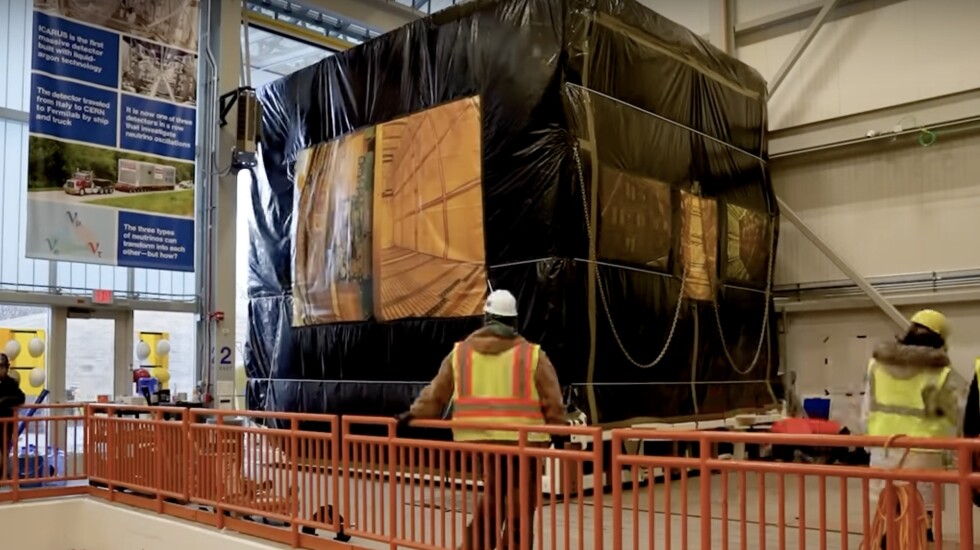
There’s a weird discrepancy in the field of particle physics. Basically, it’s unclear why we exist.
All the matter and antimatter particles produced during the Big Bang should have annihilated one another, according to Sam Zeller, a physicist at Fermilab in Batavia.
But our presence on Earth — as well as the existence of Earth and everything else — is evidence that this didn’t happen.
In an effort to solve this mystery, Fermilab is conducting a new, flagship experiment called the Deep Underground Neutrino Experiment, known as DUNE.
Zeller is deputy director for part of the project, which involves more than 1,000 scientists around the world. She spoke with WBEZ’s Indira Khera about why they’re going to start blasting neutrinos — the most abundant particles of matter in the cosmos but very hard to catch — underground from Illinois to South Dakota. A condensed transcript, lightly edited for clarity, follows.
Indira Khera: Start very simple. What is a neutrino?
Sam Zeller: Neutrinos are one of the most abundant particles in the universe. There are actually trillions passing through us every second.
Neutrinos are produced in the sun and the atmosphere in a supernova burst. So neutrinos are really interstellar messengers.
Because neutrinos are so abundant and produced by so many different sources, they have profound implications for our understanding of the universe in many different ways.

Khera: What other properties make these little particles so interesting to scientists?
Zeller: Neutrinos have many strange and unique properties, some of which we’re only recently learning about.
My favorite part about neutrinos is that they can change into different types as they travel. We refer to this as neutrino oscillations. We know that there are three types of neutrinos and that they can oscillate from one type to another as they travel.
It took us a long time as scientists understand this. But we’re using this phenomenon of neutrino oscillation to answer a lot of important questions about neutrinos and are working to try to make connections to the things we observe in the universe.

Khera: What can studying this oscillation through projects like DUNE tell us about the universe?
Zeller: We’re hoping that DUNE will answer one of the biggest questions surrounding neutrinos, sort of the holy grail of neutrino physics at the moment. And that is whether or not neutrinos can help explain why we exist.
When the universe was formed at the time of the Big Bang, more than 13 billion years ago, equal amounts of matter and antimatter were created, and that matter and antimatter should have annihilated. But that did not happen. And we know that because we are here.
So there’s something that caused the imbalance that avoided the cancellation of matter and antimatter in these very early stages of the history of our universe.
Khera: So would neutrinos have been a part of that imbalance?
Zeller: Exactly. And in order to get at that question, we’ll be producing beams of neutrinos and anti-neutrinos at Fermilab to be a part of the DUNE experiment. We’ll be looking very intently at whether or not those neutrinos and anti-neutrinos behave in slightly different ways.
Khera: How is all of this going to work?
Zeller: In a nutshell, DUNE will be sending neutrinos an 800-mile distance from Fermilab to South Dakota. And this is a really big deal. We’ve never sent a beam of neutrinos from an accelerator this large a distance across the Earth.
There are parts of the project that are located here at Fermilab. And there are other parts that will be based in South Dakota, where we’ll be housing sensitive detectors a mile underground to catch the neutrinos.
Khera: What is so exciting to you about the potential answers — or even the questions that are unearthed by observing these neutrinos through DUNE?
Zeller: I find it so exciting because we’re really rewriting textbooks as we go.
You know, when I was in college, studying particle physics and physics in general, my textbook literally said that neutrino oscillations was too speculative a phenomenon to even be mentioned.
What makes it really cool to me is that these are major discoveries happening in my lifetime and really recently.
They hold these connections to the universe because neutrinos are produced in so many ways, and they are so abundant, and they’re around us all the time.
So I find it really intriguing that we can answer these big questions, we can rewrite textbooks, and we can have this really intimate connections to how the universe works. I find that just really mind-bending.







